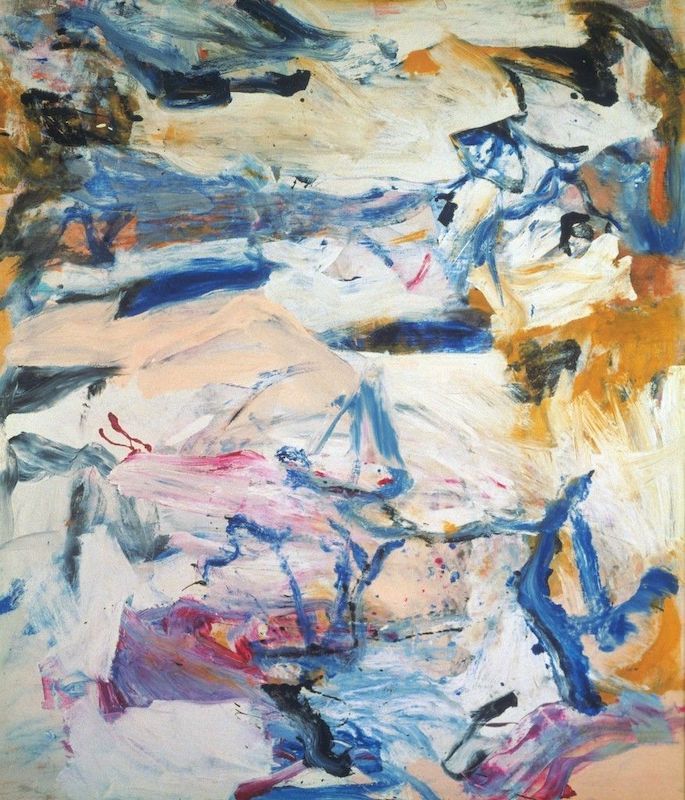
In 2004 it was 100 years ago that Willem de Kooning was born in Rotterdam. It had escaped city officials and so it is that the retrospective currently at the Kunsthal in Rotterdam and previously at the BA-CA Kunstforum in Vienna is now presented as marking the end of the centenary of his birth. Compared with the retrospective at the Tate Gallery in 1995 it is a rather poor, pared down overview. Many key works such as "Woman I" (1950-52) are missing. Undoubtedly their current owners did not feel like giving them on loan for such a minor event. And so the emphasis has come to lie on De Kooning's later work, which I don't consider his best.
What is so fascinating about his Woman series and his abstract landscapes from the 50s and 60s is their vitality and, in a way, their lightness and sense of humour. The paint has been applied with enormous vigour and ferociousness. There are many long, brisk brush strokes. Some are wide others thin. You can see patches of paint that may have dropped off his brush or spatel. You look at a corner or an area somewhere left of the middle. You notice all the brush strokes and wonder what is going on there. Why another stroke? Why add a scratch of blue on top of that still wet greyish stroke? (E.g. "Gotham News", 1955, which is both a feast for the eye and an evocation of the colours, energy and confusion of Manhattan). All of this is missing in the work of the 80s, which is more subdued, painted in longish curved strokes on a whitened canvas.
Retrospectives such as these always allow you to look and compare. It is interesting to see the differences in brush strokes and use of color in De Kooning's work from the 50s, 60s, 70s and 80s. In "North Atlantic Light" (1976), the brush strokes are predominantly horizontal. "Untitled" (1975) seems like a giant's attempt at an impressionist painting, the brush strokes trembling and curved in all directions. In the works from the 80s curves dominate and the paint tends to be applied in one or two layers. In the paintings from the 50s the yellow and blue stand out, the woman paintings from the 60s are drenched in pink and red. The paintings from the 80s are mostly done in primary colours.
As part of the exhibition a Dutch documentary from the late 70s (?) is shown in which we can see De Kooning messing about in his East Hampton studio. Thankfully the makers took the time to just let the camera register what De Kooning was doing. We see him tearing a sheet of paper from a roll, poking fun at the camera "You probably wonder what I'm going to do with this, well, I'm going to blow my nose". In one scene De Kooning sits in a chair, looking at a drawing, turning it around, adding a few pencil strokes here, erasing one there. In another scene De Kooning says of one painting that he doesn't think it is that good. I would have liked to know why, just as I would have liked to know what went on in his mind whenever he stepped back to look at the painting he was working on. Why a bluish stroke and not a yellowish one? Why does he himself think that this or that painting is better than another?
There are those who think that every time the genius sneezes is another masterpiece when the artist himself may dismiss certain works as rubbish. But what if somebody else likes it and is willing to buy it? It brings in money and if he or she likes it, then why not sell it? A few years later it may then be included in a retrospective where critics will say that it is one of the artist's lesser works, when he or she may have agreed.
This brings me back to one of my opening remarks. Willem de Kooning was a great painter who has created some astonishing paintings, which strike me every time I see them. His work is not served well by this exhibition though. This is not De Kooning’s fault. Any oeuvre has its peaks and lows. It is understandable that the organizers could not bring together every work they would have liked to include. But sometimes it is better to show less than to compensate for what you cannot show by sheer quantity.
Willem de Kooning is at the Kunsthal, Rotterdam, The Netherlands until 3 July 2005.
Links
Works by Willem de Kooning in the Hirshhorn collection.